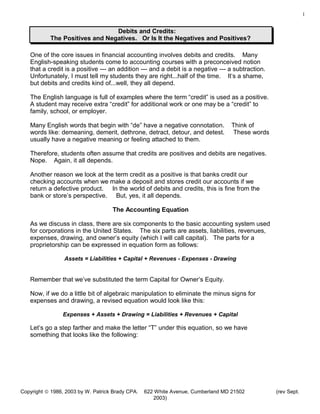More Related Content
Similar to DeadClerkDrawing14Sept2003.DOC
Similar to DeadClerkDrawing14Sept2003.DOC (20)
DeadClerkDrawing14Sept2003.DOC
- 1. Debits and Credits:
The Positives and Negatives. Or Is It the Negatives and Positives?
One of the core issues in financial accounting involves debits and credits. Many
English-speaking students come to accounting courses with a preconceived notion
that a credit is a positive --- an addition --- and a debit is a negative --- a subtraction.
Unfortunately, I must tell my students they are right...half of the time. It’s a shame,
but debits and credits kind of...well, they all depend.
The English language is full of examples where the term “credit” is used as a positive.
A student may receive extra “credit” for additional work or one may be a “credit” to
family, school, or employer.
Many English words that begin with “de” have a negative connotation. Think of
words like: demeaning, demerit, dethrone, detract, detour, and detest. These words
usually have a negative meaning or feeling attached to them.
Therefore, students often assume that credits are positives and debits are negatives.
Nope. Again, it all depends.
Another reason we look at the term credit as a positive is that banks credit our
checking accounts when we make a deposit and stores credit our accounts if we
return a defective product. In the world of debits and credits, this is fine from the
bank or store’s perspective. But, yes, it all depends.
The Accounting Equation
As we discuss in class, there are six components to the basic accounting system used
for corporations in the United States. The six parts are assets, liabilities, revenues,
expenses, drawing, and owner’s equity (which I will call capital). The parts for a
proprietorship can be expressed in equation form as follows:
Assets = Liabilities + Capital + Revenues - Expenses - Drawing
Remember that we’ve substituted the term Capital for Owner’s Equity.
Now, if we do a little bit of algebraic manipulation to eliminate the minus signs for
expenses and drawing, a revised equation would look like this:
Expenses + Assets + Drawing = Liabilities + Revenues + Capital
Let’s go a step farther and make the letter “T” under this equation, so we have
something that looks like the following:
Copyright © 1986, 2003 by W. Patrick Brady CPA. 622 White Avenue, Cumberland MD 21502 (rev Sept.
2003)
1
- 2. Expenses + Assets + Drawing = Liabilities + Revenues + Capital
|
Debit | Credit
|
|
|
|
|
Debits are on the left and credits on the right. Not a hard choice at all and this
decision of one or the other is tailor-made for the 1’s and 0’s of computer binary
coding. Nothing could be simpler, right?
Unfortunately, my experience with students has been just the opposite. Debits and
credits can be a stumbling block to learning as we often have to move on in a class
before students have mastered the basic concept. Debits and credits are certainly
not the most important aspect of accounting, but they are the basis of the accounting
system. And there’s also a good deal of beauty and symmetry to this little system.
So here’s how I explain debits and credits to my students and a mnemonic that I have
used with them since about 1986. Many students have told me the mnemonic alone
helped them get through a portion of their accounting studies.
If we take the equation above the horizontal line of the “T” and place those elements
on the appropriate sides of the equation, we get something like this:
Expenses + Assets + Drawing = Liabilities + Revenues + Capital
|
Debit | Credit
Expenses | Liabilities
Assets | Revenues
Drawing | Capital
|
|
Think of the beauty of this system. Assets are on the left, while liabilities and capital or common
stock are on the right. Expenses and revenues are each on different sides of the vertical line.
Expenses and drawing both reduce capital or stockholders’ equity, so they are on the opposite side
from the capital account. It’s simple, but perfectly logical and symmetrical.
Let’s tighten this up a little bit, use first initials instead of whole names, and see what
we get.
____________________________©
|
D | C
E | L
A | R
D | C
While the spelling is atrocious, you can sound out “dead clrc” to something that
sounds like “dead clerk”. Before giving my students “dead clrc”©, I tell them a
Copyright © 1986, 2003 by W. Patrick Brady CPA. 622 White Avenue, Cumberland MD 21502 (rev Sept.
2003)
2
- 3. fabricated story about a fictitious salesperson in the shoe department of a JC Penney
store who died during the Christmas shopping rush. Yes, the story is hokey, and
perhaps the mnemonic is too. But it works. And many students remember debits
and credits based on that fictitious deceased shoe department clerk at JC Penney.
Once they remember DEAD CLRC as the normal or positive balance for debits and
credits, they can usually take it from there on their own.
While accounting may be difficult, it’s our job as instructors to simplify and distill the
complexities. And, where we can perhaps our students and we can have a little
fun doing it, even at the expense of a dead clerk.
W. Patrick Brady CPA MBA
Allegany College of Maryland
12401 Willow Brook Road
Cumberland MD 21502
Copyright © 1986, 2003 by W. Patrick Brady CPA. 622 White Avenue, Cumberland MD 21502 (rev Sept.
2003)
3
